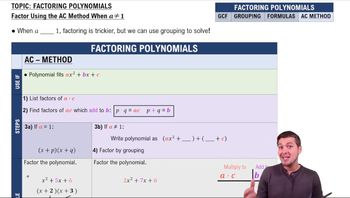Table of contents
- 0. Review of Algebra4h 16m
- 1. Equations & Inequalities3h 18m
- 2. Graphs of Equations43m
- 3. Functions2h 17m
- 4. Polynomial Functions1h 44m
- 5. Rational Functions1h 23m
- 6. Exponential & Logarithmic Functions2h 28m
- 7. Systems of Equations & Matrices4h 6m
- 8. Conic Sections2h 23m
- 9. Sequences, Series, & Induction1h 19m
- 10. Combinatorics & Probability1h 45m
0. Review of Algebra
Factoring Polynomials
Problem 23a
Textbook Question
In Exercises 23–48, factor completely, or state that the polynomial is prime. 2x³ - 8x
 Verified step by step guidance
Verified step by step guidance1
Step 1: Identify the greatest common factor (GCF) of the terms in the polynomial. In this case, the GCF of \(2x^3\) and \(-8x\) is \(2x\).
Step 2: Factor out the GCF from each term in the polynomial. This means you will divide each term by \(2x\) and write the polynomial as \(2x(x^2 - 4)\).
Step 3: Observe the expression inside the parentheses, \(x^2 - 4\). Notice that it is a difference of squares, which can be factored further.
Step 4: Apply the difference of squares formula, \(a^2 - b^2 = (a - b)(a + b)\), to \(x^2 - 4\). Here, \(a = x\) and \(b = 2\), so \(x^2 - 4 = (x - 2)(x + 2)\).
Step 5: Combine the factored terms to express the completely factored form of the polynomial: \(2x(x - 2)(x + 2)\).
Recommended similar problem, with video answer:
 Verified Solution
Verified SolutionThis video solution was recommended by our tutors as helpful for the problem above
Video duration:
2mPlay a video:
Was this helpful?
Key Concepts
Here are the essential concepts you must grasp in order to answer the question correctly.
Factoring Polynomials
Factoring polynomials involves expressing a polynomial as a product of its factors. This process often includes identifying common factors, applying special factoring techniques like difference of squares, or using methods such as grouping. Understanding how to factor is essential for simplifying expressions and solving polynomial equations.
Recommended video:
Guided course

Introduction to Factoring Polynomials
Greatest Common Factor (GCF)
The Greatest Common Factor (GCF) is the largest factor that divides two or more numbers or terms without leaving a remainder. In polynomial expressions, finding the GCF allows for simplification by factoring it out, which can make the remaining polynomial easier to work with. Recognizing the GCF is a crucial first step in the factoring process.
Recommended video:

Graphs of Common Functions
Prime Polynomials
A prime polynomial is a polynomial that cannot be factored into simpler polynomials with rational coefficients. Identifying whether a polynomial is prime is important in algebra, as it determines whether further simplification is possible. Understanding the criteria for primality helps in recognizing when a polynomial is already in its simplest form.
Recommended video:
Guided course

Introduction to Factoring Polynomials

 7:30m
7:30mWatch next
Master Introduction to Factoring Polynomials with a bite sized video explanation from Patrick Ford
Start learningRelated Videos
Related Practice










